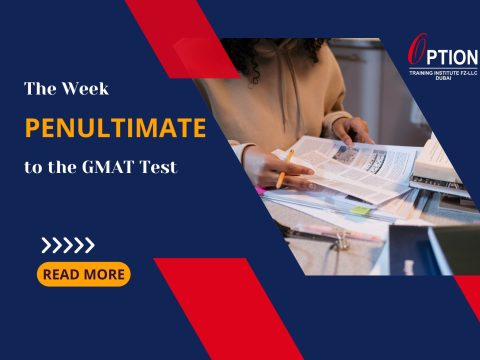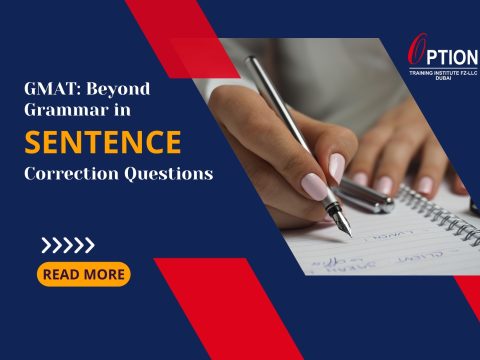- For Enquiry -
- +971 509267126
- +971 551207626
- enquiry@optioneducation.ae
On a lighter note, I’d suggest yoga, the art of living classes, or anything – fishing or even ballet – that allows the test taker to take his mind off the GMAT! But strangely, all the test taker wants the week before the test is endless hours of GMAT practice.
The idea is to squeeze into the last few days as much, and sometimes more than is humanly possible regarding productivity. As a result, it is not uncommon to discover that all the last-minute effort, apart from being insane, rushed, and tiring, was counterproductive in the long run. How frustrating!
When we talk about how the week penultimate to the test is best spent, we presume that the test taker has already put in the required study for the test and is eager to know how best to use the days before the exam.
So, for someone who has done the drill of classes, coaching, practice, problem-solving, and a few full-length simulated tests, the penultimate week should truly be a time to compose himself, engage in constructive exchange with trainers and peers, and revise the course by doing one full-length test – timed and done in entirety – every day or every alternate day.
One major hitch in the preparation plan drawn up and implemented by test takers is that they do practice tests at their convenience. This often means that they do not write the AWA task, overlook the IR Section, and decide they have time only for the Math and Verbal Sections, or even worse, only the Math section!
This means that the GMAT practice test that the student was supposedly undertaking to get acclimatized to the length of the test ends up being an exercise in futility. More comfortable and ‘convenient’ interfaces with tests leave the test taker with an inaccurate experience. He continues to do what he is good at or comfortable with and avoids all that ‘tests’ him.
He also fails to build up the reserve required to sit through the three-and-a-half-hour test. As a result, the real-day experience is something quite different; by the time the test taker has rubbed his eyes through the AWA and IR sections, he has been in front of the computer for 60 minutes before the Math section – 75 minutes – comes on, followed by the verbal section, another 75 minutes.
So, in the last few days before the test, make sure to practice whole tests and get used to the duration of the test so that you have the tenacity to sit through and perform to your best.
If the test taker has already done simulated practice tests, is well versed with the length and content of the GMAT, and has gotten around to handling virtually all its nuances, another viable way of spending the week penultimate to the test is working on portions of the test.
Write essays and have them evaluated by trainers, pick out those topics of Math and Verbal that are disconcerting and work on polishing the strategy required to tackle them, and give a fair amount of time to the IR section despite rumors that business schools do not consider the IR score.
Lastly, spend the last few days getting the sleep–wake cycle in place. Rest, eat, and work sensibly. Do not get into spirals of work and keep up all night. Contrary to what most grew up hearing, burning the midnight lamp does not always pay! The GMAT requires acute responsiveness, immense innovation, and patience – qualities that come easier to a rested mind and body. So, however inconsequential a discussion of this kind may seem when discussing strategies for the GMAT exam, the truth is that rest, food, and prayer are essential mantras to get the GMAT right.
GOOD LUCK! Stay connected with Option Education and explore more blog posts.
Option Training Institute, Dubai, has constructed worksheets and practice materials on qualitative skill-building preparation. After introducing the modalities of each test section, our trainers draw out the class plan and cover each topic theoretically and then practically by engaging the class in discussions and problem-solving sessions.
Although there is a timeline for the courses, our trainers have been given the liberty to extend course durations to suit the group’s needs. So, when someone joins for a 7-week course, he is apprised that the course may take a week or two more to complete satisfactorily. This flexibility in the course duration is unique to our institute and allows the trainers and the students to work without any pressure.
- Filter by
- Categories
- Tags
- Authors
- Show all
- All
- ACT
- ACT Essay
- ACT Exam
- ACT Experts
- ACT Prep
- ACT Preparation
- ACT Test
- ACT Test Takers
- ACT Training
- ACT Writing Section
- Algebra
- AP
- AP AB
- AP BIOLOGY EXAM
- AP Calculus AB
- AP Classes
- AP Course Prep
- AP Dubai
- AP Exam Test
- AP Exams
- AP Test
- c-trap
- Chemistry Subject SAT
- Class Schedules
- Concepts
- COVID 19
- Digital SAT
- DIGITALSAT
- DSAT
- EVEN
- Factors
- GEOMETRY
- gmat
- GMAT MATH
- GMAT Prep
- GMAT Preparation
- gmat quant
- GMAT Scores
- GMAT Section
- gmat test
- GMAT VERBAL
- GMAT Verbal Section
- GRE
- GRE Prep
- GRE Test
- INSEAD
- Junior SAT
- LNAT
- Math
- mathematics
- MBA
- MBA Program
- Multiples
- New SAT
- NEW SAT ESSAY
- Number Properties
- NUMBERS
- Objectives of AP
- ODD
- Option
- QS Event
- Remainders
- SAT
- SAT Biology
- SAT BIOLOGY E/M
- SAT CANCELLATION
- SAT Chemistry Subject Test
- SAT Dubai
- SAT Essay
- SAT Exam
- SAT Grammer
- SAT II
- SAT Language Section
- SAT MATH
- SAT Prep
- SAT READING SECTION
- SAT Subject
- SAT Subject Test
- SAT Test
- SAT Test Takers
- SAT Trainers
- SAT Writing
- SAT Writing Section
- Skills
- Starting Classes
- Subject SAT
- Subject SAT Math Level 2
- Subject Test
- Test Prep
- Test Takers
- Training Institute
- Triangles









